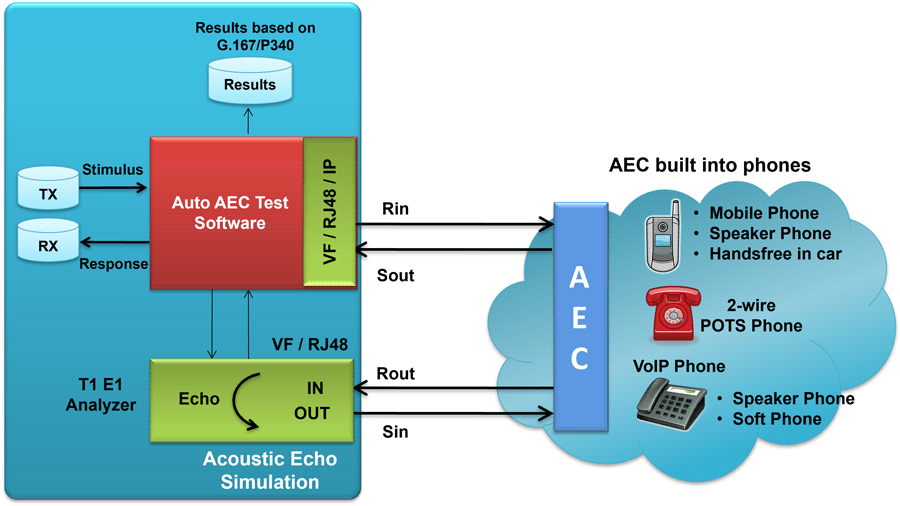Newsletter: GL Announces Acoustic Echo Compliance Test Software
Welcome to a September 2010 issue of GL Communications' Newsletter providing information and insight into our latest Automated Acoustic Echo Compliance Test Software Per G.167 and P.340.
Overview
Automated Acoustic Echo Cancellation (AEC) Compliance Test Software (PKB081) is a GL Communications' feature rich application used to perform acoustic echo cancellation testing in accordance with ITU-T Specifications, G.167 (03/1993) and P.340 (05/2000).
The application uses GL Communications' T1/E1 Analyzer products and customers AEC hardware or software to perform Acoustic Echo Canceller testing. Rin and Sin files (Stimulus and Echo) are prepared by Automated AEC Test Software in accordance with user inputs Rout and Sout are captured and processed.

Operational procedure
As depicted in the above diagram, Rin is the source signal (from the far end), which goes through Acoustic Echo Canceller (AEC) and Sout is the echo cancelled signal, which comes out of AEC. The leakage from Rout to Sin is due to the acoustic echo. The module, which includes AEC, Rin, Rout, Sin and Sout, can be a Sound Card, a Mobile Phone, a Regular Phone, an IP Phone, or a SpeakerPhone.
Shown below is an example setup, where GL's DEC (Digital Echo Canceller) software is used as a substitute for a real AEC. Automated AEC Test Software performs a full analysis (with detailed displays) that results in a "Pass" or "Fail". The same setup may be used with an AEC within a Gateway, if the inputs to the Gateway are all digital. Automated AEC testing concepts are implemented within the software for various End to End Applications (Mobile, TDM, and VoIP) scenarios.
Important Features
- Simulates an actual acoustic echo path with acoustic filter types (Small, Medium, Large Office), Echo path delays and losses
- Features such as filter, attenuate, and delay are available as well as slow filter coefficient variation as a function of time to simulate a real acoustic environment
- Real-time as well as off-line analysis with tabular Pass/Fail results
- Simulate acoustic echo for Analog (Mobile Phone), digital (Gateway ), and Packet (VoIP IP Phone) applications
- Auto or Manual control of the AEC during testing
- Auto analysis of the response according to G.167 (03/1993) & P.340 (05/2000) requirements
- Detailed graphical and tabular results for individual and overall tests
- Generation of report with the plots (Report Analysis)
- Options to recalculate test parameter across different region in the waveform (Plot Results)
- Option to zoom-in on any test results to investigate further
- Supported on Windows XP with user-friendly Graphical User Interface
- Compatible with GL's Universal HD T1 E1 cards and USB Portable T1 E1 units
AEC Testing Scenarios
Stimulus / Simulation all Digital (TDM Applications): In this scenario, the AEC is assumed to be located in the network. Acoustic echoes are simulated within the GL's T1 E1 platforms digitally. The generation of the stimulus signal and the capture of the response signal is also performed by GL's T1 E1 platforms.
Stimulus / Simulation all Analog (Mobile Phone Applications): In this scenario, the AEC is assumed to be in a mobile phone and accessed thru an analog interface. Again GL's T1 E1 platforms with analog interfaces are used to convert analog signals to digital and subsequent processing is performed digitally Level adjustment accessories are used between mobile phone and the Dual T1 E1 card to accommodate various signal levels and impedances.
Stimulus RTP (Ethernet) / Simulation Analog or Digital - (VoIP IP Phone Applications): In this scenario, the stimulus and response signals are generated by GL's RTP Toolbox™ thru an Ethernet interface and simulation is performed digitally by GL's T1 E1 platforms, whether accessed thru analog or digital interfaces.
Reports and Analysis
AutoAECTest performs a full analysis (with detailed displays) that results in a "Pass" or "Fail". Supports *.csv and *.xls format files for reporting AEC Test results analysis.
The graphs below depict the result analysis per G.167. For the "Pass" cases, both the convergence time and the residual should meet the requirements of G.167.

For the 'Fail' cases, either one (convergence or residual) or both (convergence and residual) does not meet the requirements of G.167. Plot Result option enables to recalculate test parameter across different regions in the waveform.
For comprehensive information on the application, please refer Automated Acoustic Echo Compliance web page.

 Back to Latest News Page
Back to Latest News Page